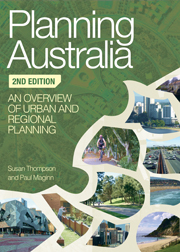Book contents
- Frontmatter
- Contents
- Contributors
- Figures and tables
- Discussion points and case studies
- Preface
- Acknowledgments
- Abbreviations
- Table of statutes
- Introduction
- Part I Frameworks
- 1 What is planning?
- 2 Planning and governance
- 3 Planning as a profession
- 4 An historical perspective
- 5 Statutory planning
- Part II Key Issues
- Index
4 - An historical perspective
from Part I - Frameworks
- Frontmatter
- Contents
- Contributors
- Figures and tables
- Discussion points and case studies
- Preface
- Acknowledgments
- Abbreviations
- Table of statutes
- Introduction
- Part I Frameworks
- 1 What is planning?
- 2 Planning and governance
- 3 Planning as a profession
- 4 An historical perspective
- 5 Statutory planning
- Part II Key Issues
- Index
Summary
Key terms: planning history; postwar reconstruction; environmental management; urban renewal; neo-liberalism; national urban policy.
An historical perspective to planning injects an appreciation of the roots of current conditions and crises, the evolving contexts in which they are situated, and comparative benchmarking of local, regional and national experiences (Harris & Smith 2011). The ‘long view’ provides a deeper understanding of planning aspirations, achievements and limitations. Yet planning scarcely features in general accounts of Australian history – at best it is a footnote within wider environmental and urban narratives. There have been attempts to redress this neglect (Freestone, Garnaut & Hutchings 2002), the treatment often shifting between stories of heroism, failure, ‘cities as they might have been’, ‘top-down’ plan-making and ‘bottom-up’ community insurgencies.
In this chapter, planning is depicted as a product of its time and as an activity continually being redefined to serve emerging new challenges. Five main themes are the evolving relationships between public and private (market) interests, the influence of international ideas, the rise of environmental consciousness, the shaping of policy by community groups, and the role of the federal government (traced mainly through the chapter’s case studies).
- Type
- Chapter
- Information
- Planning AustraliaAn Overview of Urban and Regional Planning, pp. 73 - 97Publisher: Cambridge University PressPrint publication year: 2012
- 4
- Cited by



